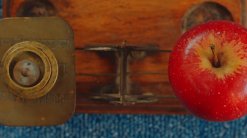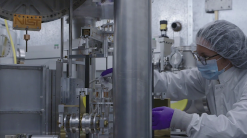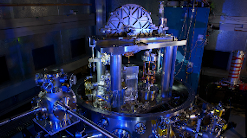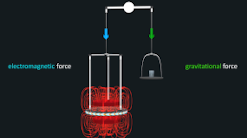
Phenomena that are very small, very fast, or very far away become within the reach of today’s improved measurement instruments and processes. How does that impact research and development? Manufacturing? Quality control? The future is bright!
[The image shows NIST mechanical engineer Leon Chao adjusting the NIST-4 watt balance. Through its measurements of Planck’s constant, a quantity at the heart of quantum physics, the NIST-4 watt balance contributes to the international agreement to define all base measurement units in terms of fundamental constants of nature.]
When something is very small, very large, very fast, or very far away, accurate measurements become even more important. Consider some of the big questions in science today and how the constants will help us answer them.
The Last Artifact - Problematic Artifacts
Videos
What problems arise from using a material object as a standard of measurement?
Journal Thread #1 / Prompt 4 - One Little Problem
Activities
Step into the shoes of a lead metrologist and plan how you would persuade your country's leaders to make the switch to using universal constants as standards.
Activities
Examine some extreme questions in science—problems that involve very large or very small measurements—and consider the value of more accurate and precise tools in answering these questions.
When he was complimented for his brilliant insights, Einstein often said: “I had a Planck to stand on.” His pun revealed an important fact: Max Planck provided a model and a constant that became the foundation of much of modern physics.
Activities
Max Planck, a renowned physicist, theorized that energy flows in packets called quanta. His research uncovered a universal constant and laid the foundations of quantum physics. Learn more and explore a simulation.
NIST in 90: Measuring Planck’s Constant
Web Links
In this 2016 video, NIST physicist Darine Haddad uses a cup of coffee and sugar cubes to explain the significance of Planck’s constant. In 2017, after this video was recorded, NIST measured a new value of the Planck constant with an uncertainty of only 13 parts per billion. This measurement contributed to the final value the revised International System of Units (SI) approved in November 2018.
New tools and techniques help us make discoveries, and the discoveries make new tools and techniques possible. That is how science and technology, measurement and innovation, come together in powerful synergy—when phenomena working together are greater than the sum of their separate parts.
NIST Role Models - Innovating with Constants
Videos
How does the move to universal constants support scientific innovation? The NIST Role Models explain.
Journal Thread #2 / Prompt 3 - Chicken or Egg?
Activities
Watch the NIST Role Models discuss innovation, then think of something you'd like to measure. Can you come up with a new tool or technique?
Activities
Read about the dynamic relationship between science and technology in innovation. Looking at advances in measurement, imagine the effect that changes in measurement standards will have on future developments, and engage with related Mini-STEM activities.
One of the NIST-developed tools that will propel innovation in the future is the Kibble Balance (also called Watt Balance). This tool enables constant-based measurement of mass anywhere—no longer will metrologists have to think about Le Grand K as they standardize their work.
Activities
In this activity, you’ll develop a model for equating force and mass, and then look at the actual Kibble balance at NIST and discover how it works.
Operating Principles of the NIST-4 Watt Balance
Web Links
The watt balance lets researchers determine the mass of an object indirectly via two measuring modes that determine two different quantities: the strength of the magnetic field, and the current running through a coil of wire.
What have you learned about innovations in measurement? Challenge yourself with these questions.
What more can you learn about innovation?
Activities
Use what you've learned about the Kibble balance to model its properties.














